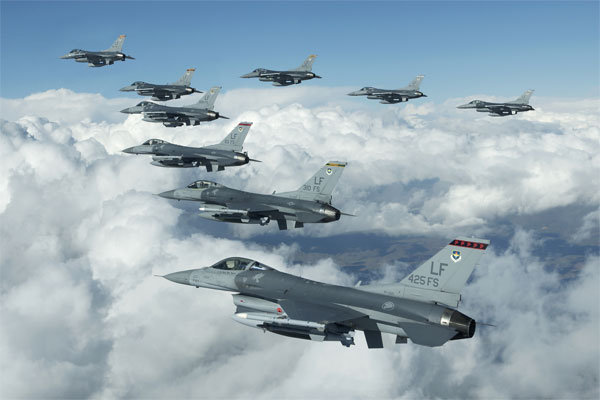
Does Biden’s Base in Poland
Break a Fundamental NATO Promise?
Ted Snider / AntiWar.com
(July 18, 2022) — On June 29, Biden introduced his presence at the NATO summit in Madrid, by announcing that the US would establish a permanent headquarters for US forces stationed in Poland. Biden announced that “The new base will be home to the first permanent US forces on NATO’s eastern flank.”
It will be the first permanent US base because the US and NATO promised that there would be no permanent base in NATO’s eastern flank. At a time when the US should be doing everything possible to nurture a diplomatic solution to Russia’s invasion of Ukraine, Biden, instead, antagonized Russia by breaking that promise and enhancing NATO’s eastward expansion.
US officials parried the broken promise agreement thrust through the sophistry of distinguishing the permanent headquarters from the resident troops who will be on rotational deployment. They say that the word “permanent” is an accurate description of the headquarters but not of the combat troops stationed in the headquarters. However long troops remain in a base, though, they always rotate through, making it very unlikely Moscow will be assuaged by the rotating troops in a permanent base argument.
In May 1997, when it was clear that the US would break its promise and extend NATO east toward Russia’s borders, President Clinton at least offered Boris Yeltsin and Russia the compensation of the NATO-Russia Founding Act on Mutual Relations. That act promised that as NATO expanded east toward Russia, there would be no “permanent stationing of substantial combat forces.”

Biden’s announcement clearly breaks that promise. A permanent headquarters that “will include a command post, garrison, and field support battalion” seems to be a clear violation of the act.
Though the individual soldiers may not be permanently stationed at the base, US Army V Corps soldiers will be permanently stationed at the base: there will be “a steady, consistent rotation of forces,” seemingly making it a “permanent stationing of substantial combat forces.”
Biden’s announcement referred not just to a permanent base, but to “the first permanent US forces on NATO’s eastern flank.” And though the White House has often needed to walk back Biden’s words, it did not walk back these ones. A Defense Department fact sheet used the exact same words. Secretary of Defense Lloyd Austin used the exact words on Twitter.
V Corps functioned in Europe for almost a century. It was inactivated in 2012. In 2020, it was reactivated to provide “additional command and control capability focused on synchronizing US Army, allied and partner nation tactical formations operating in Europe.” V Corps became fully operational in November 2021, working “alongside NATO allies and regional security partners to provide combat ready forces” and to “improve interoperability and to ensure an appropriate collective posture of deterrence and defense.”
Although the US may never have taken the NATO-Russia Founding Act totally seriously, it was very important to Russia. Richard Sakwa, professor of Russian and European Politics at the University of Kent, told me that the Russian government is aware that we are living in a very different world and that the act is now dead. Alexander Lukin, who is Head of the International Relations Department at HSE University in Moscow, told me that he doesn’t “think that the Russian government has any illusions about that document.”
That the act is still important to Russia, though, may be suggested by the terms Putin chose in laying out an opening negotiating position in the December 2021 draft security treaty he sent to the US Putin wanted a written guarantee that NATO troops deployed to eastern European countries that entered NATO since 1997 would be removed. That is, he wanted the promise of the NATO-Russia Founding Act to be kept.

The US may have never taken the Founding Act wholly seriously. It was a deceptive anodyne designed to soothe painful symptoms while masking that the problem was still there and could re-emerge. According to M.E. Sarotte in her new book, Not One Inch, the act was carefully written to allow a future president like Biden to wiggle out of the agreement.
In the section called “Political-Military Matters,” the act sates “NATO reiterates that in the current and foreseeable security environment” there would be no “permanent stationing of substantial combat forces.”
Sarotte writes “the NSC assured Clinton that with these words, the United States had avoided making ‘an absolute commitment, in case future circumstances changed.’ The definition of terms such as ‘substantial’ was intentionally left vague, and Western negotiators would successfully resist all efforts to define it.”
Lukin goes further, calling the Founding Act “a surrender of Russia’s interests and of the principle of equality.” Like Sarotte, he says “there were no serious obligations” and says that “It was signed by Yeltsin to save face while he was begging Clinton for money.”
Clearly a “permanent headquarters for US forces,” that is “accompanied by a field support battalion” that the White House specifically called “the first permanent US contingent on NATO’s eastern flank” fits any definition of “substantial.” But the deliberate language of “current and foreseeable” allowed Biden to exploit the language of the act to break the promise of its spirit, choosing to antagonize Russia and risk prolonging the conflict between NATO and Russia at precisely the moment that creating diplomacy and not antagonism is desperately needed.
Ted Snider has a graduate degree in philosophy and writes on analyzing patterns in US foreign policy and history.

House NDAA Would Authorize Training for Ukrainian Pilots to Use US Warplanes
(July 17, 2022) — The House version of the 2023 National Defense Authorization Act (NDAA) that was passed Thursday night includes an amendment that would authorize $100 million to train Ukrainian pilots on how to use US warplanes.
Ukraine has been asking the US for F-15s and F-16s, but its pilots are only trained to use Soviet-designed MiG-29s and Sukhoi planes. According to Defense News, it would take about three months to train pilots to fly the F-15s and F-16s at a basic level.
The pilot training amendment was sponsored by Rep. Adam Kinzinger (R-IL), an ultra-hawk who has repeatedly called for direct US military intervention in the war. Kinzinger said the US was ready to start training Ukrainian pilots at the Columbus Air Force Base, Mississippi, and possibly at another base in Texas.
“There is no doubt to me that when this war ends, Ukraine is going to have to be outfitted with Western military equipment. Plus, there’s just no more MiGs left and no more MiG supplies,” Kinzinger said.
So far, the US has not sent any fighter jets to Ukraine and declined a Polish offer to transfer MiG-29s to the Ukrainians earlier in the war. But the Biden administration has shown its willingness to escalate its military aid for Ukraine despite the risk of provoking Moscow.
Ukraine is piling pressure on the US to send more advanced equipment and sent two Ukrainian fighter pilots to Washington as part of their lobbying effort.
It’s not clear if Kinzinger’s amendment will make it to the final version of the NDAA. The Senate still has to pass its version, and then the two chambers have to negotiate the final bill that will head to President Biden’s desk.
The House version of the NDAA authorizes $850.3 billion in military spending, $37 billion more than Biden requested. The Senate is looking to raise it even higher as its version would authorize $858.5 billion.
Posted in accordance with Title 17, Section 107, US Code, for noncommercial, educational purposes.